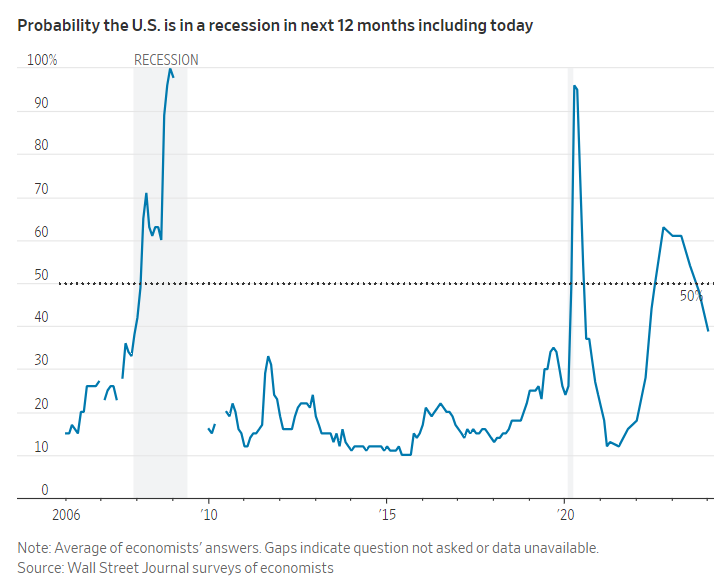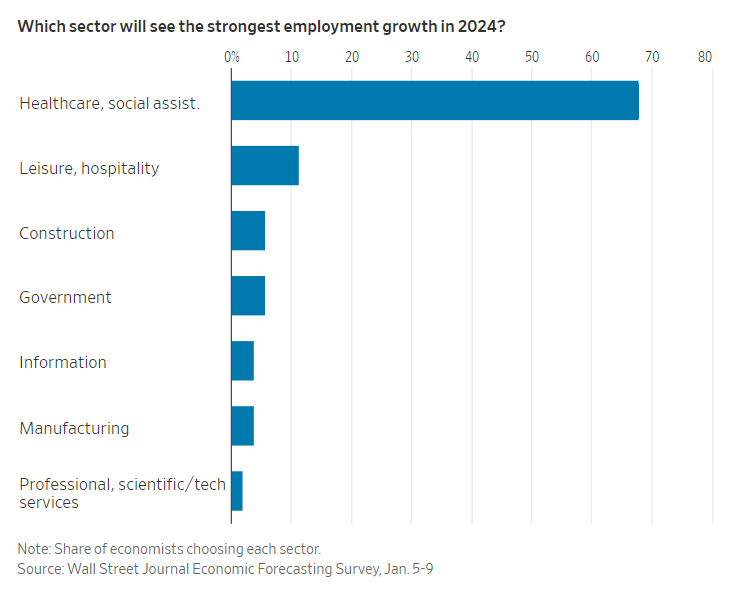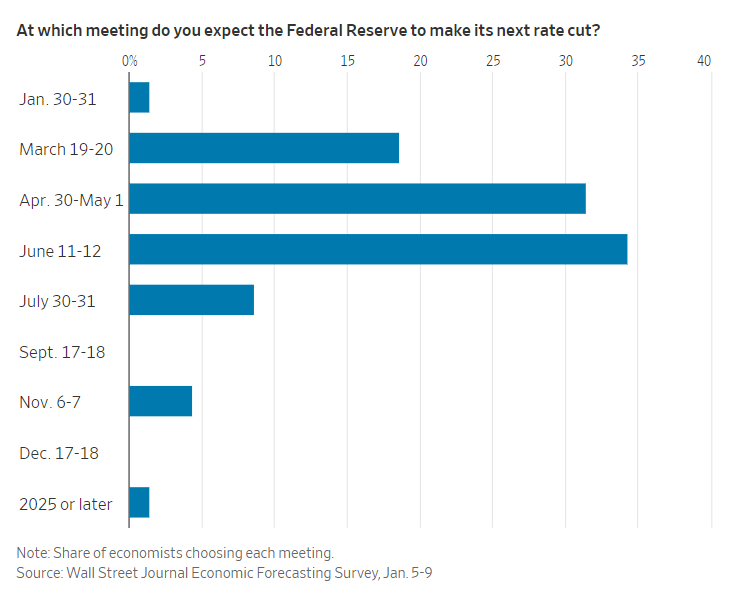
By Harriet Torry and Anthony DeBarros
Jan. 15, 2024
The good news is the probability of a recession is down sharply, according to The Wall Street Journal’s latest survey of economists. The bad news is that, for a lot of people, it is still going to feel like a recession.

Economists said U.S. employers are likely to continue adding jobs this year, but at a much slower pace. PHOTO: ERIC THAYER/BLOOMBERG NEWS
Business and academic economists surveyed by the Journal lowered the probability of a recession within the next year, to 39% from 48% in the October survey.
“A recession in the year ahead seems less likely than it appeared at the start of 2023, since interest rates are trending lower, gas prices are down from last year, and incomes are growing faster than inflation,” said Bill Adams, chief economist at Comerica Bank.
Still, economists on average expect the economy to grow just 1% in 2024, about half its normal long-run rate, and a significant slowing from an estimated 2.6% in 2023.
“This is less a recession and more of a growth stop,” said Rajeev Dhawan, an economist at Georgia State University.

American employers should keep adding jobs in 2024, but at a much slower pace than in recent years. Economists expect payroll gains to average 64,000 a month this year, less than a third of the 225,000 average in 2023 and far below 399,000 in 2022.
With job growth falling below the growth of the labor force, economists expect the unemployment rate will climb from 3.7% in December 2023 to 4.1% in June and 4.3% by the end of the year. While that is low historically, a 0.6 percentage point increase in the jobless rate would imply a net one million more Americans unemployed by the end of the year, relative to this past December. Moreover, in the past that much of an increase in unemployment has almost always occurred during recessions, according to one widely followed rule.
One reason a growing economy may still feel to many like a recession is the wide dispersion in performance across industries. Cyclical sectors—those most sensitive to the economy’s ups and downs—are likely to struggle in 2024, even if there isn’t an overall economic contraction, economists say.
“Cyclical sectors of the economy are pulling in the reins on employment, and we look for companies to further tighten the reins as they lose pricing power,” said Kathy Bostjancic, chief economist for Nationwide Mutual.
A quarter of economists expected manufacturing to see the weakest job growth this year, while 17% cited retail, and 12% said transportation and warehousing. Those are all cyclical sectors. The majority of economists said healthcare will be the sector with the strongest job growth in 2024, while 11% cited leisure and hospitality.

That would be a continuation of trends in 2023, when hiring was also concentrated. Leisure and hospitality, government and healthcare together accounted for the bulk of job creation in 2023.
Transportation and warehousing employers have been cutting jobs in recent months after hiring aggressively in the wake of the pandemic, and manufacturing employment was essentially flat in 2023 as the sector struggled with high borrowing costs.
With growth remaining positive, the second condition of a soft landing is inflation returning to around 2%, the Federal Reserve’s target, and that too is in the cards for 2024, the survey shows. Economists see inflation as measured by the personal-consumption expenditures price index, excluding food and energy, falling to 2.3% at the end of 2024 from 3.2% this past November. That chimes with Fed officials’ projections. At their December meeting they said inflation would fall to 2.4% by the end of 2024.
The Fed is widely expected to cut rates this year, though economists are divided over when. Markets currently expect the first cut at the Fed’s March 19-20 meeting, but only 19% of economists surveyed agree. Roughly a third expect the first rate cut at the April 30-May 1 meeting, and just over a third at the June 11-12 gathering.

Economists also expect fewer rate cuts than the market, seeing just one or two quarter-percentage point cuts by the end of June, compared with three by markets. The current target is between 5.25% and 5.5%, a 22-year high.
The survey of 71 economists was conducted Jan. 5-9, before the release of the Labor Department’s consumer-price index report, which showed inflation firmed in December after rapid cooling through most of 2023.
Write to Harriet Torry at harriet.torry@wsj.com and Anthony DeBarros at anthony.debarros@wsj.com
Dow Jones & Company, Inc.



